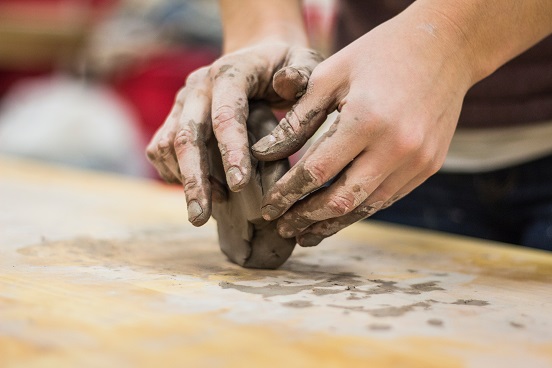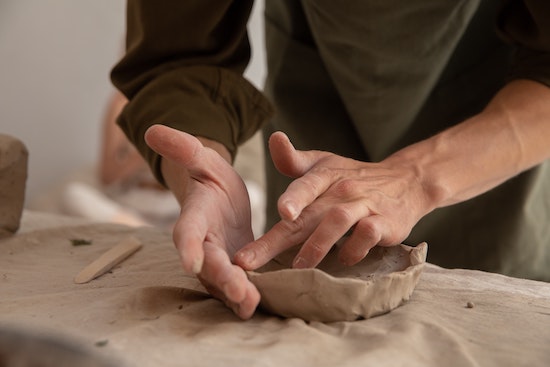
North Seattle College Ceramics Instructor Liz Duarte has been instrumental in shaping the Continuing Education program into one of unprecedented popularity. Before COVID sent us all home and shuttered the arts studios, our ceramics classes filled up within minutes of registration opening. While we continue to work and learn from home, our instructors have gotten (extra) creative. Liz is teaching Introduction to Ceramic Sculpture this winter and has taught Ceramics for All and Pit Fire Ceramics, all virtually. We checked in with Liz to find out how it’s been going, as well as to learn more about how she came to love ceramics and why it continues to inspire her.
Please give us some background on your life in ceramics. When did you first discover you had an affinity for it?
My favorite outdoor activity as a child was playing in the mud. I loved poetry, music and drawing and I loved to redecorate my room. I spent many an hour moving posters and furniture to find the most pleasing arrangement. I think that helped to develop my desire for esthetically pleasing solutions. I didn’t discover clay until college. I didn’t know what I wanted to focus on, but I had gone to Figure Drawing classes on my own and really enjoyed them. Figure Drawing was my first class at Southwestern College in Chula Vista, CA. Then came design, then sculpture and then Ceramics! I got more into the idea of getting my Associates Degree at that point. They had a really cool Clay Club and I had a great group of friends. I assisted with summer classes for kids, and then I started working for San Diego Job Corps in the Arts and Crafts Department.
When did you feel called to be a professional artist and instructor?
As I was finishing up my degree I started hearing from Ripon College in WI. I knew I wanted to major in Art. In my class there were five Art majors and it was a small town, so we were the artists. I loved it - I even spent summers there! We had huge studios full of equipment and amazing professors.
Gene Kain was my sculpture professor. His wife Evelyn was my Art History Professor. They became family. When my appendix ruptured, they nursed me back to health. I walked their dog Panda through the wetland trail behind the Art Department. It was such an amazing and supportive community. They encouraged me to go to graduate school. I think Gene worried that if I didn’t go, I might stay at Ripon College forever! I probably would have...
 I did some more summer art camps for kids and then my Painting professor, Kevin Brady recommended me for a job as a drawing teacher at University of Fond du Lac. I tried too hard to be professional, but once I relaxed and I got to know the students it became fun for me. Around that time, I was accepted to George Washington University in Washington, DC. I taught for the program and worked closely with J.J. McCracken who was the lab tech at the time. That studio was our clubhouse and we made it pretty awesome! We were there all the time and once again, I found myself in another amazing community, but an expensive place to live. I taught a couple of hand building ceramics classes for the college before moving to Seattle. It was at that time that I began working with the National Council of Education for the Ceramic Arts (NCECA) conference. My job was to organize a small group of volunteers each year to fill goodie bags.
I did some more summer art camps for kids and then my Painting professor, Kevin Brady recommended me for a job as a drawing teacher at University of Fond du Lac. I tried too hard to be professional, but once I relaxed and I got to know the students it became fun for me. Around that time, I was accepted to George Washington University in Washington, DC. I taught for the program and worked closely with J.J. McCracken who was the lab tech at the time. That studio was our clubhouse and we made it pretty awesome! We were there all the time and once again, I found myself in another amazing community, but an expensive place to live. I taught a couple of hand building ceramics classes for the college before moving to Seattle. It was at that time that I began working with the National Council of Education for the Ceramic Arts (NCECA) conference. My job was to organize a small group of volunteers each year to fill goodie bags.
I began looking for a place to work and found Pottery Northwest and The Pottery School. I can’t say that there was a particular moment when my destiny presented itself, rather it was a series of opportunities that made it apparent.
The ceramics community at North Seattle College is most inspiring. I love the school setting and the idea that there is always more to discover. With teaching in particular, I love figuring out ways to communicate ideas. That’s what makes it interesting for me.
Continuing Education ceramics classes are incredibly popular. Why does the art form have such tremendous attraction and fascination for students?
Working with ceramics requires you to adapt to the drying time of the material. Coming to class once a week is not enough, the work needs your constant attention. The more you invest, the more your skills improve and it shows in the work you do. There is so much to learn in your first (beginning) class and practice makes better. It’s easy to get hooked!
The first ceramics class you taught virtually for Continuing Education was Ceramics for All this spring. What was that like?
It was nice that half of the class was made up of students who have taken ceramics classes with me before. That definitely helped me feel comfortable venturing into uncharted territory. That said, everyone was very generous and forgiving especially with the technical issues - we figured it out together!
Was anything particularly surprising about teaching a ceramics class online? Are there any advantages?
There is a lot more planning involved in online classes. We were able to spend more time on the design aspect of the work - something that generally happens outside of the studio. We were able to get a glimpse into each other’s process and that was really nice.
What were some challenges you faced and how did you address those?
The greatest challenges were logistical. We had to invent new systems and do it on the fly. There were things we never had to think about before: What exactly would students need and where would they get it? What is a safe way to have the work fired? Answering these questions took teamwork and creative solutions.
You have done much to build the North Seattle College Ceramics program. Tell us about some of your proudest your accomplishments.
Back when I was the lab tech for the North Seattle College I worked with the Art Department and the Sustainability Committee to purchase a pug mill. It was great to combine my interests in sustainable solutions with my work in ceramics.
The CE Student Art Show has been an amazing addition to the program. It’s really great to be able to showcase the talents of this community. I am grateful to Amanda Knowles and the other Art faculty for supporting this. And we were even able to move it online this year for our first Virtual Art Show!
What do you enjoy most about teaching ceramics? What excites you about your students’ process?
I really like it when my students get it... when they become aware that they are artists and are confident in their abilities.
What are you looking forward to most when we can get back into the studio with students?
Socializing, teaching on the wheel and potlucks!
We are eagerly anticipating the day when we can welcome ceramics students back into the studio. Until then, we hope you will check out the ceramics classes our dedicated and creative instructors are offering online.
Learn more about Liz Duarte and Introduction to Ceramic Sculpture.